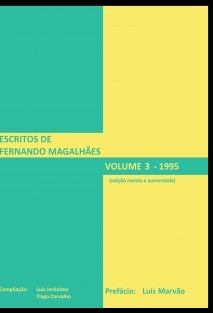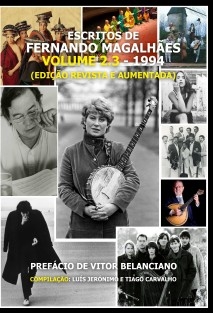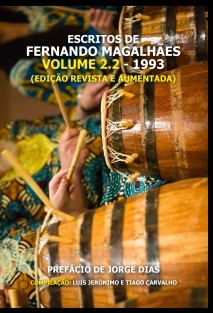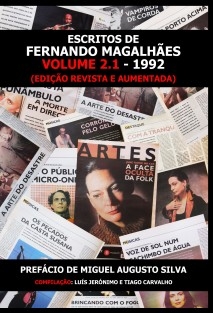25.9.23
Crepúsculo Dos Deuses - Programa Nº 362 - Especial "Sol Invictus"
0 visualizações 25/09/2023 (acabado de colocar)
22.9.23
Moolakii Club : Printed Media (fanzines) (cassette culture)
MOOLAKII CLUB : PRINTED MEDIA
Label zine for Wirral based Moolakii Club Audio Interface
Peripheral and underground downtempo electronica on cassette CD download
MCPM007 July/August - 2023 : Episode 7 - TWGX £2
New Releases
On the Horizon
Interviews (TWGX)
News
Cover Tracks
ther Bits and Bobs
Fanzine - A Cores, com 12 páginas, papel 80gr, A5 + Autocolante da editora + cartão + Cassette --> tudo £2
13.9.23
Livros sobre música que vale a pena ler - Cromo #101: Stephen Prince - "A Year In The Country - Straying From The Pathways"
título: A Year In The Country - Straying From The Pathways
nº de páginas: 244
isbn: 978-1-9160952-0-5
data: 2019
1ª Edição / 1st Edition
Stephen
Prince
A Year
In The Country
Straying
From The Pathways
Hidden
Histories, Echoes of the Future’s Past and the Unsettled Landscape
Published
by: A Year In The Country, 2019
ISBN:
978-1-9160952-0-5
Copyright
© Stephen Prince, 2019
Edited
and typeset by Ian Lowey, Bobcap Book Services, Manchester.
Cover
Image: A Year In The Country
Contents:
Introduction
– 9
Notes on
the Text – 13
Preface:
A Loose Definition and the Recurring Themes of Hauntology and its Confluence
and Intertwining with Otherly Folk
1.
Explorations of an Eerie Landscape: - 19
Texte
und Töne – The disruption, The Changes, The Edge is Where the Centre is: David
Rudkin and Penda’s Fen: An Archaeology, The Twilight Language of Nigel Kneale,
The Stink Still Here – the miner’s strike 1984-85 – Robert Macfarlane –
Benjamin Myers’ Under the Rock: The Poetry of a Place.
2.
Fractured Dream Transmissions and a Collapsing into Ghosts: - 40
John
Carpenter – Prince of Darkness, Halloween III: Season of The Witch, Village of
the Damned, Christine – Nigel Kneale – Martin Quatermass – John Wyndham’s The
Midwich Cuckoos
3.
Hinterland Tales of Hidden Histories and Unobserved Edgeland Transgressions: -
62
Adrian
McKinty’s In The Morning I’ll Be Gone – Clare Carson’s Orkney Twilight – David
Peace’s GB84 – Tony White’s The Fountain in the Forest.
4.
Countercultural Archives and Experiments in Temporary Autonomous Zones: - 72
Jeremy
Sandford and Ron Reid’s Tomorrow’s People – Richard Barnes’ The Sun in the
East: Norfolk & Suffolk Fairs – Sam Knee’s Memory of a Free Festival: The
Golden Era of the British Underground Festival Scene – Gavin Watson’s Raving
’89 – Molly Macindoe’s Out of Order: The Underground Rave Scene 1997-2006.
5. The
Village and Seaside Idyll Gone Rogue: - 83
Hot Fuzz
– The Avengers’ “Murdersville” – The Prisoner – In My Mind – Malcolm Pryce’s
Aberystwyth Mon Amour.
6.
Albion in the Overgrowth and Timeslip Echoes: - 104
Requiem
– The Living and the Dead – Britannia – Detectorists
7. In
Cars – Building a Better Future, Perculiarly Subversive Enchantments and Faded
Futuristic Glamour: - 121
In the
Company of Ghosts: The Poetics of the Motorway – Joe Moran’s On Roads: A Hidden
History – Chris Petit’s Radio On – Autophoto – Martin Parr’s Abandoned Morris
Minors of the West of the Ireland – The Friends of Eddie Coyle – Killing Them
Softly – Langdom Clay’s Cars: New York City 1974-76
8.
Brutalism, Reaching for the Sky and Bugs in Utopia: - 137
Peter
Chadwick’s This Brutal World – Bladerunner – J.G. Ballard – Ben Wheatley –
High-Rise – Perter Mitchell’s Memento Mori – Brick High-Rise.
9.
Battles with the Old Guard nad the Continuing sparking of Vivid Undercurrents:
- 159
A Very
Peculiar Practice – Edge of Darkness
10.
Lycanthropes, Dark Fairy Tales and the Dangers of Wandering off the Path: - 169
The
Company of Wolves – Danielle Dax – Red Riding Hood – Wolfen – Hansel &
Gretel: Witchhunters – The Keep.
11. The
Empty City Film nad Other Visions of the End of Days – Survival and Shopping in
the Post-Apocalypse: - 187
Day of
the Triffids – Into the Forest – Night of the Comet – The Quiet Earth.
12.
Universe Creation, Spectral Lines in the Cultural Landscape and Reimagined
Echoes from the Past: - 206
Hauntology
– Hypnagogic Pop – Synthwave – D.A.L.I.’s When Haro Met Sally – Nocturne’s Dark
Seed – Beyond the Black Rainbow – Mo’Wax, UNKLE, Tricky, Massive Attack,
Potishead, DJ Shadow, Andrea Parker – Ghost Box Records, The Focus Group,
Belbury Poly – The Memory Band – The Delaware Road – Rowan : Morrison –
Howlround – Mark Fisher – the BBC Radiophonic Workshop – Adrian Younge’s
Electronique Void – DJ Food – Grey Frequency – Keith Seatman – Douglas Powell –
Akiha Den Den – The Ghosty in the MP3 – Black Channels – The Quietened Village
– The Corn Mother.
INTRODUCTION
A Year
In The Country is a project which has a broad reach, but at its core is an
exploration of what could be called “otherly pastoralism”, where the further
reaches of folk music and culture meet and intertwine with the parallel worlds
of what has come to be known as “hauntology”;1 a cultural subgenre
characterized by spectral echoes of the past and a yearning for lost
progressive futures.
The
project has produced book and music releases alongside over 1,000 posts on its
website, consisting both of artwork and written pieces inspired by, and
relating to, that otherly pastoral/spectral hauntological intertwining.
It
travels along, and connects, multilayered and often hidden pathways and
signposts that have sometimes become buried in the cultural undergrowth of
time; from explorations of the eerie landscape to hinterland tales of hidden
histories via Brutalist architecture, acid folk, “edgelands”, electronic music
innovators, folkloric film and photography, hazily misremembered televisual
tales and transmissions, folk horror, the faded modernity and future ruins of
road travel, apocalyptic “empty city” films, dark fairy tales, imaginary film
soundtracks, dreams of lost futures, photographic countercultural festival
archives and experiments in temporary autonomous zones.
I began
A Year In The Country in 2014, but the roots of it probably stretch back to
several years before to a time when I was living in a city and just out of
curiosity I listened to a friend’s copy of the compilation album Gather in the
Mushrooms: The British Acid Folk Underground 1968-1974, which was released in
2004 and curated by Bob Stanley of Saint Etienne. The musical explorations on
the album and its general pushing back of the boundaries of folk music seemed
to open up something in my mind.
However,
though the inspiration to create A Year In The Country can be directly
attributed to listening to that album, in truth I can probably trace the
lineage of its creation back to a childhood spent, at one point, living in a
small rural village where I enjoyed bike-riding, climbing hills, damming rivers
and so forth. But it was not all bucolic high jinks as around the same time I
became increasingly aware of the dark clouds of the threat of the Cold War.
Indeed, the surrounding country side was littered with signs of previous
conflicts such as old military fortifications; from time-to-time unexploded
weapons would be found and airforce jets would regularly fly overhead at levels
so low it almost seemed as though you could reach up and touch them as they
practiced their radar evasion techniques.
In later
childhood years, I would live on the edge of the country side and one of my
playground haunts was a semi-developed camp site which had formerly been some
form of military base and which contained derelict, rubbish-filled, submerged
air raid shelters that friends and I would convince each other were haunted.
When visiting relatives, we would play on another “edgeland” site under buzzing
electricity pylons in an area that it now quite lush and verdant but which at
the time was full of discarded household appliances. We would tumble down the
hill, past these old fridges and washing machines – which we were warned not to
play in, in case we became trapped – towards a river that would change colour
to orange, blue, green and so on, in accordance with which chemicals were being
emptied into it from the dye factory upstream.
This was
all accompanied by a growing appreciation of exploratory, dystopic and
catastrophic science fiction in books and via television that, at times, was
probably too advanced for me; from the hyperinflation and societal collapse of
Noah’s Castle (1979) to the final series and book of Nigel Kneale’s Quatermass
(1979) and its extraterrestrial harvesting of youth tribes, via John Wyndham’s
post-apocalyptic Day of the Triffids (1951) and its sometimes terrifying 1981
television adaptation as well as the invaded village threat of his The Midwich
Cuckoos (1957).
It also
took in amongst other tales the likes of the resource-depleted future of
Soylent Green (1973) and the mysterious incarceration of Patrick McGoohan’s
character in the picturesque but subtly unsettling Village in The Prisoner
(1967-68). In addition to this, there was the sense of being confused but
intrigued by the sometimes fringe and more exploratory areas of science
fiction; the alternative historical timelines and sometimes hallucinogenic
nature in some of Michael Moorcock’s and Philip K. Dick’s fiction from the
1960s and 1970s, and the darkly dystopian, post-apocalyptic near future world
of Alan Moore and David Lloyd’s V for Vendetta (1982-89) – episodes of which I
originally read as they were published in the early-to-mid 1980s, in the
Warrior comic anthology.
All of
this seemed to somehow subconsciously percolate and impart a sense of the
countryside as both a place of beauty and respite as well as somewhere which
might possess hidden undercurrents and a dark flipside, and this alongside an
interest in imagined parallel worlds would eventually provide fertile ground for
the roots of A Year In The Country.
When I
formally instigated the project in 2014 I knew little of work that explored the
flipside of the pastoral, but coincidentally and quite by accident I seemed
stumble upon and become fascinated by it, just as it truly flowered and began
increasingly to share territory with hauntology, to the extent that there now
seems to be an abundance of work available in both these related areas.
At the
core of such work there area number of common cultural reference points, inspirations
and touchstones often from the 1970s and the later 1960s, such as the towering
trio of films The Wicker Man (1973), The Blood on Satan’s Claw (1971) and
Witchfinder General (1968), which have since become labeled – and to a degree
define – folk horror; the unsettling and challenging British children´s fantasy
television that was possibly a bit too odd for its intended audience such as
The Changes (1975), The Owl Service (1969-70) and Children of the Stones
(1977), alongside the darkly anti-pastoral Penda’s Fen (1974); as well as old
public information films and TV idents, and the electronic music innovations of
the BBC Radiophonic Workshop and so on.
Many of
these, and related works, are present and referred to in this book, but much as
the music collected on Gather in the Mushrooms… did with my perceptions of what
constitutes folk, I also wanted to push the boundaries back a little to
consider work which, directly or indirectly, takes that canonic core as its
inspiration for the creation of new work; explores the undercurrents and
flipsides of the 1980s; digs down further and allows us glimpses of Albion in
the overgrowth within the context of contemporary television; and points us
towards where hitherto unexplored otherly pastoral hinterlands, hauntological-esque
specters, lost futures and reimagined echoes of the past might be found.
I hope
you enjoy this book as much as I have enjoyed discovering these “patterns under
the plough” (or under the tower block, motorway and amongst the flickers of the
cathode ray), and that it helps inspire you to set off on your own voyages of
discovery and wanderings through bountiful spectral fields.
Stephen
Prince (2nd March 2019)
1. For a
further definition of hauntology, see A Definition of Hauntology; its Recurring
Themes and its Confluence and Intertwining with Otherly Folk on page 14.
Preface:
A Definition of Hauntology; its Recurring Themes and its Confluence and
Intertwining with Otherly Folk
One of
the recurring themes of this book and the A Year In The Country project as a
whole, is a consideration of hauntology. This is a relatively niche cultural
phrase/genre name that not all readers will necessarily know of, and so, below
is a definition or overview of hauntology.
Though
it is hard to precisely define what hauntology is, it has come to be used as a
way of identifying particular strands of music and cultural tendencies. As a
cultural category it is fluid and not strictly delineated, but below are some
of the recurring themes and characteristics of hauntological work:
1) Music
and culture that draws from and examines a sense of loss, yearning or nostalgia
for a post-war utopian, progressive, modernist future that was never quite
reached.
2) a
tendency to see some kind of unsettledness and hidden layers of meaning in
previous decades’ public information films and TV idents and “a bit too scary
and odd for children, though that is who they were aimed at “television drama
programmes from the late 1960s to about 1980, which as mentioned in the
Introduction include the likes of The Owl Service (1968), Children of the
Stones (1977) and The Changes (1975)
3)
Graphic design as well as a particular kind of more-often-than not electronic,
often analogue synthesizer-based and/or previous period-orientated music that
references and reinterprets some forms of older culture and related artifacts,
often focusing on the period from approximately the mid-1960s to 1979’ and
generally of British origin.
Such
reference points include previous decades’ library music (i.e. music created
for industry use in films, television, adverts etc. rather than for public
sale); the electronic music innovations of the BBC Radiophonic Workshop;
educational materials and book cover artwork including period school text
books; Pelican non-fiction titles which tended to have a distinctive aesthetic
that combined functionality and a sense of idealism; and the stark sometimes
seemingly almost accidentally darkly-hued designs of the Penguin Modern Poets
books of the 1960s and 70s, which often featured minimalist, heavily-posterised
images of nature.
4) a
reimagining and misremembering of the above, and other, sources to create forms
of music and culture that seem familiar, comforting and also often unsettling
and not a little eerie; work that is accompanied by a sense of being haunted by
specters of its, and our, cultural past, to loosely paraphrase philosopher
Jacques Derrida who coined the phrase and created the original concept of
hauntology.2
5) The
use and foregrounding of recording medium noise and imperfections, such as the
crackle and hiss of vinyl, tape wobble and so on that calls attention to the
decaying nature of older analogue mediums and which can be used to create a
sense of time out of joint and edge memories of previous eras.
6) The
drawing together and utilizing of the above elements to conjure a sense of an
often strange, parallel or imagined world, or “Midwichian”3 Britain.
Hauntology
is often, but not exclusively, used to refer British culture and music, and it
is thought to have been first used in relation to this by the writers Marks
Fisher and Simon Reynolds to describe a loose cultural grouping of music and
attendant culture which began to coalesce in the UK around the early mid-2000s.
As a
loose genre, hauntology has retained a fair degree of cultural and aesthetic
diversity that takes in the eldritch educationalism of Ghost Box Records, the
playful psychedelic whimsy and break beats of Blank Workshop and the darkly
humorous reinterpretations of period official warning posters of Scarfolk
amongst others.
However,
the term has also been used more widely to describe the likes of American
hypnagogic pop and Italian Occult Psychedelia; musical subgenres which also
reimagine and create spectral echoes of the past but which tend to utilize as
their source material or inspiration, different areas and sometimes eras of
culture.
A
further recurring theme in this book and the A Year In The Country project as a
whole is what may initially appear to be a curious and disparate occurrence and
which it may be helpful to add some background and explanation to; the ways in
which in an area or two of music and culture, folk music and
folkloric-orientated work, of the underground, acid, psych, wyrd and otherly
variety, has come to share common ground with synthesised work and in
particular electronica of a leftfield and hauntological variety.
This is
an area of culture where the use, appreciation and romance of often older
electronic music technologies, reference points and inspirations segues and intertwines
with the more bucolic wanderings and landscapes of exploratory, otherly
pastoralism and folk culture. This has become a part of the cultural landscape
which, in the words of author, artist, musician and curator Kristen Gallernaux,
is:
“planted
permanently somewhere between the history of the first transistor, the
paranormal, and nature-driven worlds of the folkloric…”
On the
surface such folkloric and spectral electronic musical and cultural forms are
very disparate and yet both have come to explore and share similar landscapes.
What may be one of the underlying linking points with both otherly folk etc.,
and hauntology, is a yearning for lost utopias. Thus, in more otherly
folk-orientated culture this is possibly related to a yearning for lost Arcadian
idylls, whilst in hauntological culture it may be connected to a yearning for
lost progressive post-war futures that never fully came to fruition.
Both of
these intertwined areas of music and culture have revered relics: for otherly
folkloric work these may include those from that lost idyll which are
spectrally imprinted with some form of loss, such as, in the words of Rob
Young, “old buildings, texts, songs, etc., [which] are like talismans to be
treasured, as a connective chain to the past.”4
Hauntological
talismans may also include items from those referred to above: TV idents from
previous decades, public information films and television series from the late
1960s to late 1970s which have gained unsettledness and hidden layers of
meaning with the passing of time -
alongside the likes of the BBC Radiophonic Workshop and Brutalist architecture
– and which also are considered to contain spectral echoes in reference to the
aforementioned lost progressive futures.
These
two strands of otherly folkloric and hauntological work and culture may appear
at first to be cultural cuckoos in the same nest and / or strange bedfellows.
However, they have come to be seen as fellow travellers who rather than being
divided by differing surface aestethics are drawn together by a similarly
exploratory and often visionary or utopian spirit, and who respectively shadow
and inform one another’s journeys within an alternative cultural landscape.
The text
in this section is a partly revised version of that which was originally
published in the book A Year In The Country: Wandering Through Spectral Fields
(20189. An alternative version is also included in Folk Horror Revival: Urban
Wyrd – 1. Spirits of Time (2109).
1. This
period of the mid-19602 to the later 170s may be chosen as significant for a hauntologically-related
work for a number of reasons, such as during this time the optimism and, at
times, utopian ideals of the immediate post-war years to the 1960s tipped over
in Britain into a period of social, political, economic strife and conflict.
The later 1970s, and 1979 in particular, when Margaret Thatcher’s right-leaning
government was elected, is often considered to be a defining point when society
began to move towards a more neoliberal, individualistic and monetarist stance.
Also this period is when many of those creating, or interested in,
hauntological work were born, or had their formative years. As such, culture
from this era from which hauntological work often draws, has a pre-existing
resonance. Aside from its sometimes inherent oddness, such culture may also be
seen as being imbued with an antediluvian quality – broadcasts, remnants or
echoes from an “other” time and the progressive lost futures which are referred
to in the abovementioned recurring themes and characteristics of hauntology.
2.
Hauntology is a portmanteau or blending of the meanings of two words; “haunt”
and “ontology”. Ontology is the philosophical study of “being”, which focuses
on abstract questions such as whether there is such a thing as objective
reality and what kinds of things or entities exist in the universe. Ontology is
sometimes associated with foundationalist thinkers who believe that: “to arrive
at truth it is necessary to start with the most fundamental issues – to be sure
about the foundations of philosophy – and then work our way up from there to
more specific questions.” (Quoted from the Philosophy Terms website.)
3. “Midwichian”
is used to imply a sense of a conventional, comfortable, sometimes bucolic
place and society where something untoward, quietly unsettling and possibly
unexplained has happened or lurks semi-hidden beneath the surface of things. It
derives from John Wyndham’s book The Midwich Cuckoos (1957) and the subsequent
film adaptation Village of the Damned (1960) in which a pleasant rural village
is severely disrupted by a stealthy and surreptitious alien invasion. See
chapter 3 for more on this.
4.
Quoted from Electric Eden: Unearthing Britain’s Visionary Music by Rob Young,
published in 2011.
8.9.23
Crepúsculo Dos Deuses - Programa Nº 397 - Especial "The Fruits of Yggdrasil"
18 visualizações 07/09/2023 (youtube - colocado a 07.09.2023)
04.03.1988
"DA SUBMERSÃO DOS ECOS...À EXUMAÇÃO DOS SONS"
Crepúsculo Dos Deuses - Programa Nº 397 - Especial "The Fruits of Yggdrasil"
CDD397_The Fruits of Yggdrasil-19880304
Thanks: Fred Somsen, Paulo Somsen, Eugénio Teófilo.











.jpg)

















_Bubok.jpg)




















